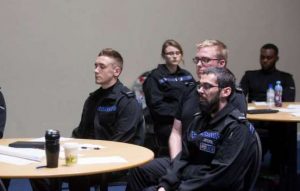We can’t stand around like innocents, slightly unsettled, scrolling on, wishing things were ‘back to normal’. We can’t sigh, say Anyway, then turn the conversation. Not anymore. — Kathleen Jamie, Cairn
Everything that exists is a condition that affects others, and is affected in turn, in a vast and complex web of causality. As part of that web, we ourselves are a condition that impacts those around us. That means if we change, so do others. — Ogyen Trinley Dorje Karmapa, Interconnected: Embracing Life in Our Global Society: Living Wisely in a Global Society

I would need a computer or TV screen and a way to secure it on a plinth or on the wall of the exhibition space. It would need to have a USB port for the memory stick that my video was saved on, or a media player of some kind. Whichever, it needs to have a facility to play the video on a loop. So I am advised by Helen, a fellow member of the G20 Artist Collective. Her hair and eyebrows are dyed orange-red and she has rings and studs on every pierceable facial surface. She is of a generation of artists who are less daunted by media technology and I am grateful for her support. But neither of us have a spare screen, nor a plinth—there is a way to go, and we are just over a week before the opening.
The video shows a snippet of the “impromptus stick performance” that I devised as part of an arts event our group created along the Forth and Clyde Canal in Glasgow. Each of us made art, inspired by the environment, at different locations along the waterway, many of them engaging the public. My offering took place at the new Stockingfield Bridge, which inspires me as a beacon of hope and optimism amid the empty glitter and bleakness that characterize much of our modern consumer world. Located at the intersection of two canals, it is a radiant, white, generously curving vision of connectivity, hung from a bold, pivotal shaft that points into a sky of potentialities. It says, “People matter! Nature matters! Beauty matters! Stop and marvel!”

I saw the potential for a performance event that would draw strangers into interaction with each other and the bridge environment. The instructions were short and simple and there were no rehearsals. At the sound of a Tibetan gong, you walked mindfully, in silence, across the bridge, carrying a white stick in an upright position. At another sound of the gong you stopped and positioned your stick at an angle that was inspired by the bridge construction and the co-performers. As you held that position, you became aware of your place in the wider constellation of things, relaxing into and enjoying a moment of interconnectedness. It went very well, despite the rainy weather on the day. Some participants after the event commented: “Relaxing, mindful, Zen; I didn’t expect it to be so much fun; I enjoyed the relationship between ‘getting it straight’ and the absence of a ‘right way;’ I felt more in tune with the bridge.”
Now we are at the next stage of the project, an exhibition in the foyer of the Trongate 103 art venue in Glasgow, documenting the event and showing new work inspired by it. Hence the video idea: a big change from my usual, conventionally framed, wall-hung artwork. I would also show a photo of one of the constellations—the one on the top of this article—and something else: some kind of playful, stick-like, as-yet-unknown response to the new indoor environment, to those particular architectural lines and spaces. As the opening date draws nearer, it becomes clear to me, that amid a great amount of technical and artistic unknowns, a situation ripe for potential anxiety, one thing would provide an anchor: the theme of interconnectedness. I am excited by this lived enquiry; bringing the concept of interconnectivity right into the heart of all aspects of this project, including the hustle and bustle of messaging and deadlines, embracing dead ends and new opportunities. There is also a sense that this is about more than just a fanciful performance or another art exhibition—that it might carry a subtle message about living in this modern, anxiety-ridden age.
The essential truth of interrelatedness hit me with awe when the building fences that had blocked my local canal walk for a couple of years were lifted and I first approached the completed bridge on a bright Sunday afternoon walk. I stood and stared, feeling myself to be part of something vast and beautiful. Such a big project would have drawn on the inspiration and skill of countless people, from the architects, planners, builders, and community ceramic artists to the gardeners who planted the banks with native species of shrubs and trees. Think of the plethora of materials used in the project, and who sourced, manufactured, packaged, drove, stored, and unpacked them, eventually putting them into place with the assistance of big machinery. It is impossible to identify and comprehend all those relationships, but extending the mind in the direction of those multitudes united toward the same goal—designing, arguing, sweating, and celebrating—is a liberating, uplifting, expansive experience.
Interconnectedness was of course the theme of the stick improvisation, and it had the elements that characterize any creative project—clear containment and openness to emergence.

Looking at this painting by Samantha Clark, for example, I intuit that every line is following a clear rule and is drawn as a fluid, improvised response to everything else that goes on. When the participants of the canal performance were raising their sticks, they did so in the same spirit, I like to think. Within the rules of the game and the container of the bridge environment, the individual, with their usual fears of doing the right thing, stops taking themselves so seriously. It is obvious, that it only works by relaxing into it, surrendering to the whole, trusting that it is okay, for a moment, not to worry about upholding a special, separate self. Letting go of the unnecessary “selfing” and anxieties that come with that, enjoying the experience of belonging to something bigger, trusting that something fresh and excellent will emerge in collaboration—all these factors play into each other.
I send a message to my neighborhood WhatsApp group and immediately receive a free offer of a TV screen just round the corner from us. Classical choral music fills the flat as we chat in the hallway, the walls hung with Christian icons. I am glad to meet this neighbor and glad that we live so close; the flat TV is surprisingly heavy to carry. Helen arrives and we save the two-minute video from my computer (where it had arrived via transfer from a friend whose husband had filmed it) to a memory stick. The TV has a USB port, but it doesn’t recognize the input. We test various options, nothing works. Another techy young friend, a PHD student doing research on AI, has a go and diagnoses that the computer is defective. He offers his own computer screen for the show, but it turns out that it doesn’t have a USB port. I send out more messages and more people are becoming involved.
Now I have a piece of obsolete equipment to deal with as well. Will I become annoyed or accept this dead end as part of this evolving process? I put the TV up on a “free share” website and there are five people interested. I write: “Bring a friend to help carry, it’s heavy” to the young man who lives two miles away. Kirsty, another G20 artist, a successful photographer, offers her iPad for the opening night, but we can’t get it to work for our purpose as it’s too old. Still, how precious the opportunity to spend time together in her tasteful living room where she likes to work at her small desk, right amid her family life. In the end, my husband, who is easily daunted by computer technology, hits on the solution: put the video up on my YouTube channel and create a QR code for it, so that people can scan it as they look at my artwork in the exhibition. Brilliant!

After the bridge performance, someone said that they thought such an organic process belonged into a natural environment—she wanted to do it in a forest. Artists, healthcare professionals, and ecologists alike advocate for more immersion in “nature”—whatever that is—to heal our alienated and ailing minds and bodies, and to start to take care of it in return.
Our two forms merge my lungs breathe with you
May a mistle thrush sing high in my branchy mind
Kathleen Jamie, from “Lone Tree” in her new collection Cairn
In his awe-inducing and bestselling book Otherlands: A World in the Making (Penguin 2022), biologist Thomas Halliday gives us a felt sense of what life on earth would have been like for the last 600 million years on these ever-shifting continents and deep in the seas, through several major extinction events. At the end he writes: “Only by altering our habits, and by endeavoring to live less exploitatively, can we prevent the changes to the environment from becoming an unparalleled catastrophe, another Great Dying.” (303)
Exposure to clouds, oceans, and forests may make it easier to sense our connectedness to life, but something else is needed too, and it can happen anywhere, amid the most hostile environment—the conscious turning of the mind and heart toward embracing this “interbeing” as Thich Nath Hanh puts it, and the understanding of the crucial importance of doing this. In a recent interview, the Buddhist ecologist and founder of the Work that Reconnects, Joanna Macy talks about this very subject and draws out how natural it is to feel kinship with life—we have just become estranged from it in the last few centuries: “We don’t have to strain to be kind and compassionate. We just have to get out of the way of what is a natural response. The tears I sometimes see in a workshop are tears of relief: I don’t have to inhabit this loneliness any longer.”
Living in an urban environment, opportunities for reconnecting forest-bathing are perhaps rare, but if we know how to relax into interconnectedness and start to play within the given parameters of any situation, knowing that everything we do affects everything else, we can find the agency to contribute to a better world. And it can be enjoyable. . . . I have been wondering about using my white wooden sticks as a sculptural element in the exhibition, but it seems technically too demanding. I turn up at the installation of the exhibition with strips of paper, cut from a large ink drawing consisting of many overlapping and inter-crossing lines, and messages written on them, such as:
Relax – and become part of the improvisation.
Salute the structures that hold you.
My intention is to create something resonant with the stick performance, as a response to the gallery environment, not sure where yet—it depends on all our works and where they fit best. At some point a down-at-heel old man bumbles into the space, notices me on the ladder sticking up my strips of paper. “I could do that,” he sneers and moves on. “Yes, you could,” I think.

Related features from BDG
Circles of Life and Death, Part One: Recalling Thich Nhat Hanh and Black Elk
Looking Afresh – At the World, Art, and Ourselves
Sowing the Seeds of Metta
Modern Koans
A Buddhist View on Capitalism and Consumerism












